
HEAD into any 4x4 workshop in the country and you’ll find some of the most-equipped toolboxes you can imagine. Huge breaker bars, deep impact sockets, rattle guns that’d break the earth in half before leaving a stuck harmonic balancer bolt in place.
Head down the road to the new housing estate and you’ll find some of the most expensive carpentry tools you can buy. High-end laser levels, lithium-powered circular saws and drill bits so expensive they should be included in the national budget.
It seems that no matter how many half-done projects lie around the house, when it comes time to deck out your toolbox for work only the best will do. It’s no surprise then that 4X4 Australia contributor and off-road show producer Dan Everett has one of the most-equipped off-road toolboxes you can buy.
You may remember his 60 Series LandCruiser on 80 diffs from about 100 years ago (best leave that alone) but as his work started needing longer trips in more isolated locations than the 60 was up for, Dan started looking towards new dual cabs to step up to the plate.
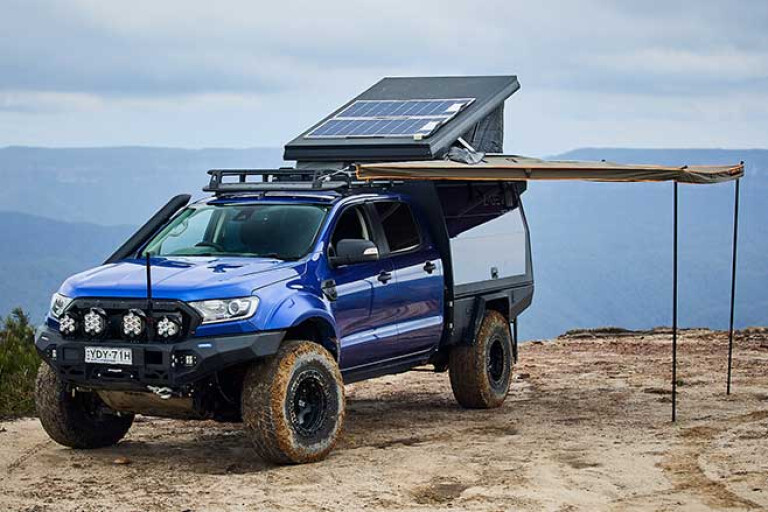
With the PX2 Ranger being one of the largest available utes at the time that met the budget, the path was set. It’s had a few forms since then, so we’ll just focus on how it sits now. Big.
Eagle-eyed readers will note there’s a whole lot more Ranger than you’d typically find parked out the front of your local jetski shop. The secret is a 300mm chassis extension by Sydney workshop Ultimate Stretches.
“I was doing a lot of towing and loaded-up travel,” Dan tells us. “I was getting concerned about how much the campers were throwing the rig around, and how much weight was behind the rear axle. Brad stretched the wheelbase out to suit a space cab tub giving me 300mm of cargo space in front of the rear axle for better weight balance, and a longer wheelbase which made the rig far less twitchy on and off road”
With the Ranger now 300mm longer, Dan set about correcting the proportions in every other direction as well. First up was an altitude adjustment. All four corners now ride on Drivetech 4x4s Enduro Pro suspension.
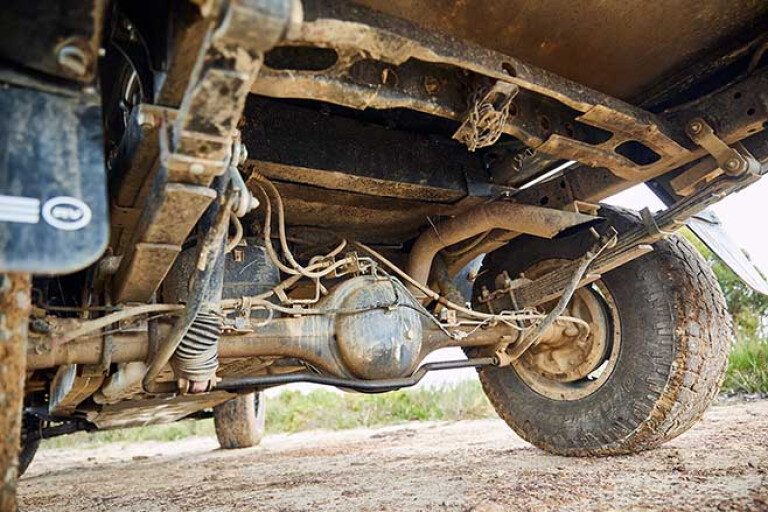
The remote reservoir shock’s extra oil capacity helps them cope with the added work of reining in such a big rig in harsh, corrugated country. Up front Dan’s dialled the adjustable struts in 50mm over standard and paired them with a set of matching Drivetech 4x4 upper control arms.
At the back, 300kg constant-load leaf springs slide between the shocks, while a Drivetech 4x4 sway bar kit helps reduce body roll without requiring excessive spring rates. Under the cab Dan’s installed a 50mm Superior Engineering body lift, allowing extra room for the wheel and tyre package at full bump, without running a huge suspension lift.
The combination, with a little bit of wheel-arch massaging from a grinder has let Dan punch the Ranger’s width out a little over 7in from stock. The 17x9in -38 KMC Robby Gordon Beadlock wheels replace the +55 factory offerings, while the tyres have jumped up to 35x12.5R17 Toyo Open Country AT2 Extremes on each corner. Up front 80mm wide Utemart flares have been fitted to cover the increase in track.
With the Rangers build sheet starting to fill out and the ever-pressing GVM figure of 3.2t looming closer, Dan started looking for options to meet his gear requirements while keeping things under the weight limit. One of the biggest factors to keep weight down is the use of aluminium rather than steel on the bar work.
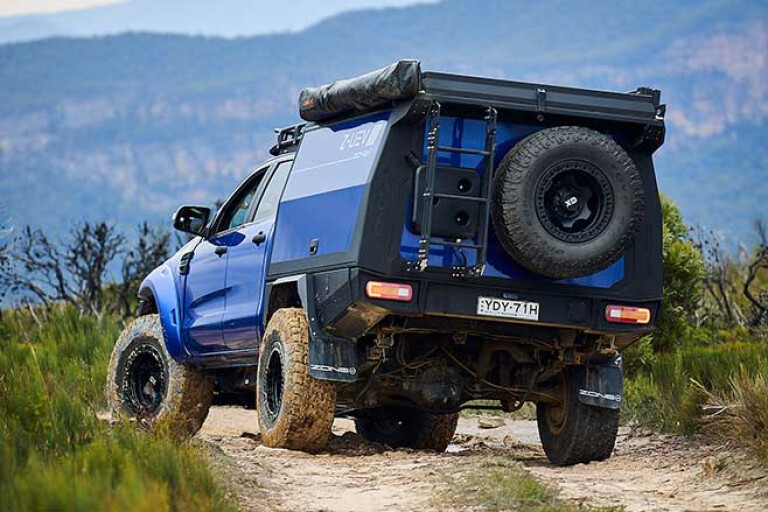
The Rival bar up front and dual-speed Drivetech 4x4 12,000lb winch are nearly half the weight of a typical steel setup. The bar also houses four laser beams of driving lights with a combination of Baja Designs LP9s and LP6s lighting the way.
From here Dan took the rig down to AE-CO 4x4 in Sydney’s west to come up with a performance package that’d not only see the big rig motoring along the tracks, but doing it reliably too. First up is the Phat Bars 4in stainless-steel snorkel; it feeds down through the guard into a Psico Performance sheet-metal airbox and high-flow pod filter before a Harrop-sourced high-flow turbo compresses the intake air. From here, a hard pipe kit feeds the air through the Harrop front-mount intercooler before it’s finally forced into the built engine.
Inside is chock-full of Engine Australia components, with Billet rods holding on to ceramic-coated pistons. The whole rotating assembly is balanced and held in with massive billet main caps on the crank. AE-CO 4x4 also fitted a gear-driven oil pump to reduce the chance of oil supply failure (a common problem in the 3.2 Duratorq) while a brand-new head was also installed with ARP head studs keeping it in place, even with increased boost. Before the final tune was loaded in, +30 per cent fuel injector nozzles were also given the nod to keep AFRs happy.
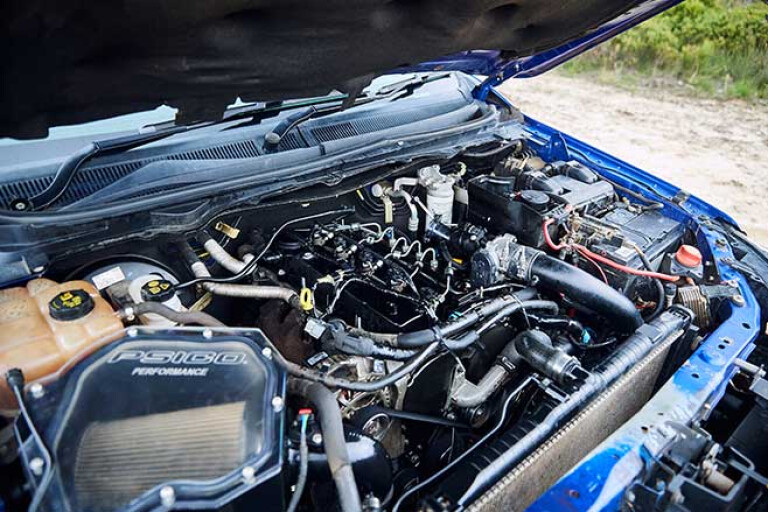
Moving back the factory auto has been opened up, and inside the standard valve body has been replaced with a Wholesale Automatics heavy-duty offering. The factory thermostat has been bypassed and the OEM cooler binned. A dual-row PWR transmission cooler has been fitted up front. A deep sump with cooling fins was also added, giving nearly 30 per cent more oil capacity.
On the inside there’s been no major modifications, but a series of small add-ons here and there make life a little easier on the road. An ECU=Shop Monster Gauge helps Dan keep an eye on engine vitals, while a GME XRS UHF has been installed under the centre console as a lifeline should help be required. With the stock rear mirror pointing at a window-full of stickers, a permanent rear-view camera feeds into a windscreen-mounted monitor.
Moving rearward Dan’s ditched the tub and optioned up a lightweight canopy from Qld-based Zone RV. The canopy is built like a high-end yacht with fibreglass composite panels making up the base of the construction; it not only insulates the entire canopy helping fridges work more efficiently but also keeps weight down, the empty canopy having a similar weight to the old tub.
Opening up the passenger side door and Dan’s optioned up a full-length kitchen making for quick meal prep on the side of the track. To the left, stacked Evakool fridge drawers make optimal use of the space without the added weight of fridge slides. To the right, a full pantry setup has storage for plates, cups, food, and even a coffee machine and toaster. Underneath, a small sink has hot and cold running water, with a full-width stainless-steel prep bench sliding out from the rearmost saddle box.
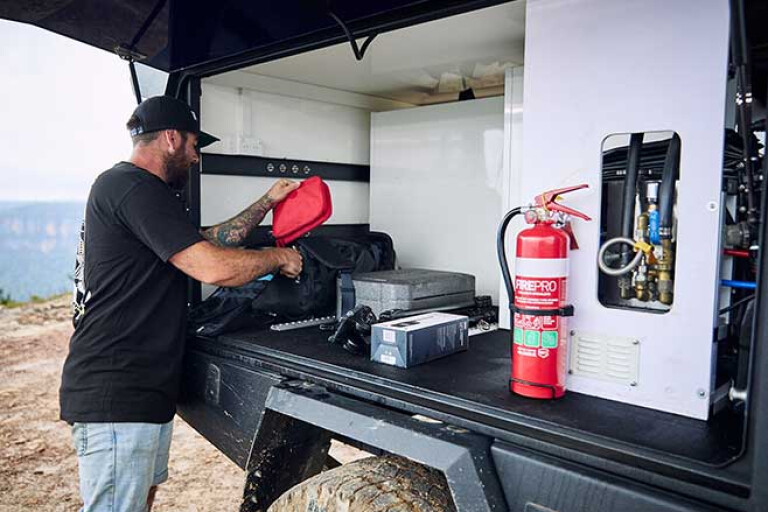
Tucked in next to the fridge is an Enerdrive system with a DC to DC charger, 2000W inverter, 200amp/h lithium battery, and Simarine digital gauge monitoring battery levels as well as the 100L water tank underneath.
Moving around to the driver’s side door, inside is a massive storage space designed to fit everything from his son’s mini bike, to space cases for camping or camera equipment. Tie-down rails spaced throughout allow things to be stored securely. There’s also an Eberspacher diesel heater unit plumbed to the kitchen sink, Quick Pitch shower, and an optional tent heater pumping up into the built-in rooftop tent for sub-zero camping trips.
While the debate between solid axle and IFS will no doubt rage on for years to come, there should be no doubt that no matter what vehicle you base your build off, the right combination of modifications and a clear direction with what you’re trying to achieve is a sure path to success.
Although Dan tells us if you’re trying to build a remote-area camera-car Ranger with billet internals and a kitchen sink you might want to set aside a casual $140,000 to get the job done.

COMMENTS